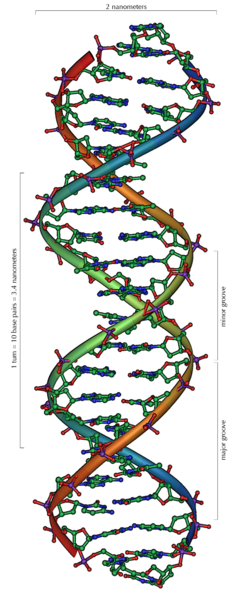Brandon Pineira
Writer
Photo from Wikimedia Commons
As many introductory biology classes teach, the transmission of information through DNA and RNA is made possible by deoxyribose and ribose, two sugars that act as molecular backbones. A third genetic polymer, however, may now join the ranks as a nucleic acid that is also capable of reproducing and evolving independently.
The genetic polymer, known as XNA, is a synthetic one that acts as a hybrid of DNA, RNA and man-made alternative molecules. Instead of deoxyribose or ribose, an alternative organic compound replaces the sugar component of the molecule’s backbone. According to a study released on April 19 by Science Journal, Philipp Holliger of the MRC Laboratory of Molecular Biology and his team succeeded in replicating XNA using enzymes that enabled the replication process.
The enzyme was one not waiting to be discovered, but to be created. Holliger and his team set out to fabricate an enzyme that would be able to replicate XNA by examining a variety of DNA polymerases (enzymes that synthesize new strands of DNA by reading existing strands), and analyzing each for their potential to “read” and synthesize XNA. By the end of the process, Holliger found several naturally occurring polymerases that could synthesize six different variants of XNA. After introducing one of these enzymes to HNA (a variant of XNA named after its use anhydrohexitol in the base), he found that XNA was able to reproduce on its own- a significant breakthrough.
The synthesis process for XNA was a bit indirect, Holliger admits.
“The new polymerases synthesized XNA through rounds of DNA-to-XNA and XNA-to-DNA synthesis. Generating polymerases that can make XNA direct from XNA will be the next step,” he told Science.
Holliger pointed out that it would be difficult to replicate XNA without DNA being involved, because those polymerases are only used to handling naturally occurring DNA.
This difficulty may also be a defining strength, however, in future applications of XNA. Many researchers consider the possibility of developing different types of XNA as aptamers (molecules that bind to specific targets). DNA and RNA aptamers are already being utilized in medicine; however, they are broken apart by biological materials in nuclei. The same characteristic of XNA that makes it difficult to replicate also makes it resilient to the naturally occurring enzymes that break down DNA and RNA. That being said, if that hurdle is overcome and XNA can be developed enough as an aptamer, it could have beneficial applications in medicine.
This is a hopeful proposition, however; some professionals feel that aptamer science is not as groundbreaking as it appeared to be when it was initially developed in the 1990s. Kareem Ahmad, a graduate student in University of California Santa Barbara’s Biomolecular Science and Engineering department, researches aptamer generation and methods development.
“The neat thing to me is that they [Holliger’s team] were able to get these proteins to recognize these modified bases,” said Ahmad.
He also addressed the lack of these aptamers’ popularity in medicine.
“There is one FDA-approved therapy that’s an aptamer therapy, and it’s a treatment for macular degeneration. In contrast, there are about twenty or so antibody therapies, and hundreds of thousands of small molecule therapies,” he said.
Unfortunately, aptamer science appears to have several issues; one of which is that its development is a comparatively complex process.
“[It’s] labor intensive, slow, inefficient, and costly,” Ahmad said. “The other issue is that there are already antibodies against practically every protein you want. Aptamers have to have a lot of advantages if you are going to displace antibodies which already exist.”
The accessibility of antibodies, then, diminishes the appeal of pursuing aptamers as an alternative.
So is aptamer science a dying field?
“A couple years ago, Larry Gold, [the original developer of aptamers] and his company, Soma Logic, single-handedly produced over a thousand aptamers against blood serum proteins,” said Ahmad. “That may bring the field back from near death, but we’ll see.”
Regardless of whether aptamer science holds potential for future progress, or is simply an academic demonstration, Holliger’s polymerases have opened up new possibilities for the field, and the study of man-made XNA molecules.











